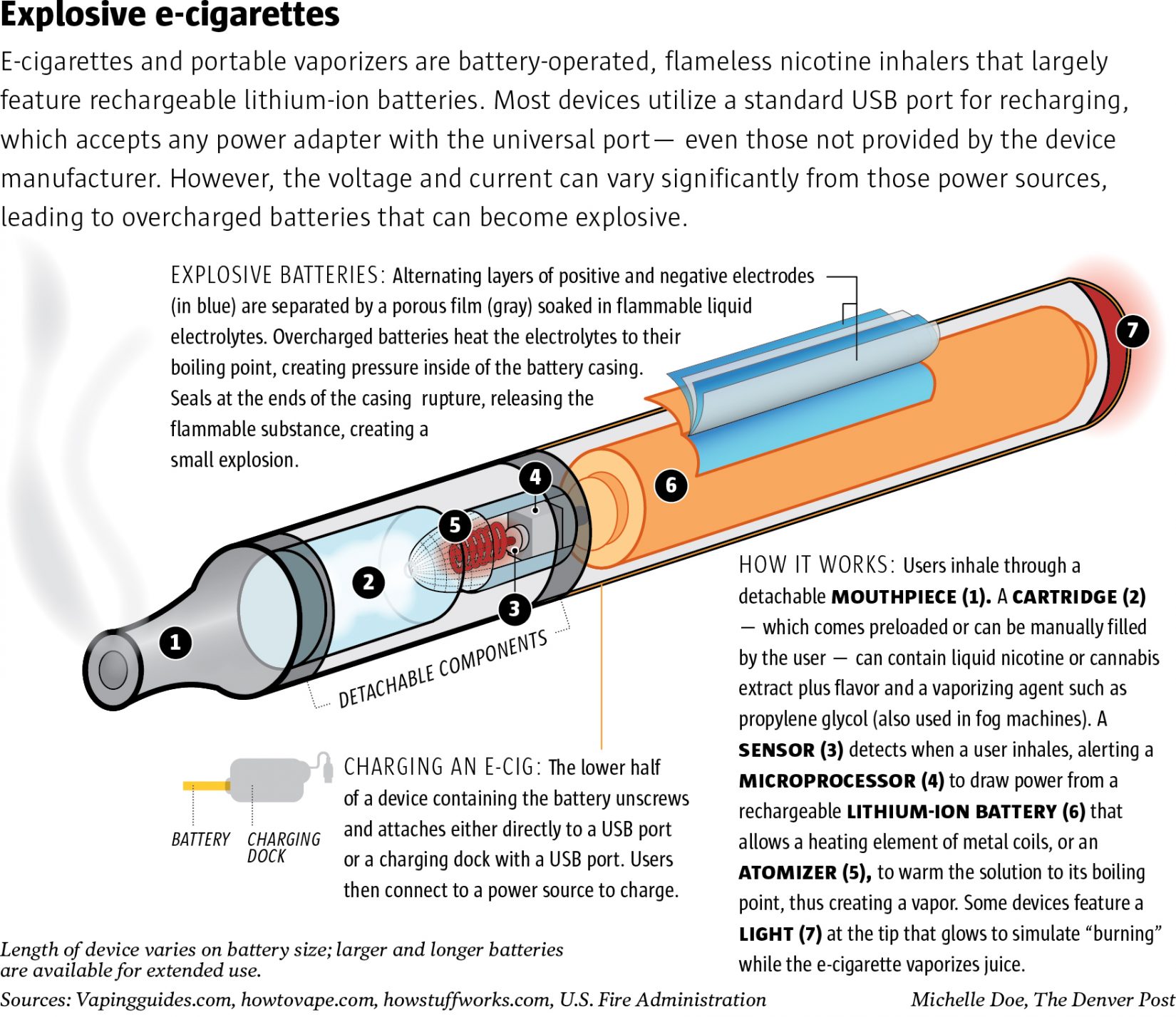Electronic cigarettes are being championed as safer alternatives to old-school tobacco, but some users — and one top Colorado doctor — say e-cigarettes can explode and cause serious burns.
Cordero Caples is recuperating at his Colorado Springs home after an e-cigarette blew up in his face in November. The 29-year-old suffered a broken neck, facial fractures, burns to his mouth and shattered teeth, said his sister, Colessia Porter.
Caples spent 10 days in a Colorado Springs hospital, and Porter is not sure when her brother will be able to go back to work as an automobile detailer.
“He has a hard time moving his body,” Porter said. “How much of a range of motion he’ll have is something we just don’t know.”
Alexander Shonkwiler is recovering in his mom’s house in Colorado Springs after an e-cigarette battery charred the 19-year-old’s right leg so badly he needed skin grafts. Shonkwiler began using e-cigs to help him break his pack-a-day habit.
“Now, I’m totally on the fence about them (e-cigarettes),” Shonkwiler said. “It was a totally freak accident. But I also have that fear I’m going to blow my face off. I might just go cold turkey instead.”

Ray Story, who heads the Tobacco Vapor Electronic Cigarette Association, said incidents of e-cigs caused injury are rare and usually involve users who are not using the right battery charger.
Dr. Anne Wagner, medical director of the University of Colorado Hospital Burn Center in Aurora, treated Shonkwiler and said she has seen four e-cigarette-related burns at the burn center from December to early January.
Wagner is worried the 2.5 million people who use e-cigs in the United States are not taking the vaping risks seriously.
“I don’t think people realize the dangers of these things,” Wagner said. “I definitely have not seen four people being hospitalized for their cigarettes being on fire.”
Use of e-cigs has been touted as a viable way to break the cigarette habit, and similarly-designed portable vaporizers are also popular among cannabis consumers. E-cigs look like regular cigarettes, cigars and pipes and are battery-powered.
They simulate tobacco smoking by producing a heated vapor, which resembles the effect of lighting up. Most of the research on e-cigs has focused on whether users are inhaling vapors that are toxic. Little research has been done on whether e-cigs can be life-threatening in other ways, including delivering burns.
Most Colorado hospitals — as well as the Colorado Department of Health and Environment — don’t keep statistics on injuries specifically caused by e-cigs. And the hospitals contacted by The Denver Post said they aren’t aware of any reported burns or other injuries caused by e-cigs.
But the growth of e-cig use has caused concerns, and accidents have prompted lawsuits.
A woman in California was awarded $1.9 million last year after she suffered second-degree burns on her legs, buttocks and hand when her e-cigarette battery exploded when she tried to recharge it.
Useful weed resources
Strain reviews: Check out our marijuana reviews organized by type — sativas and sativa-dominant hybrids, ditto with indicas.
Favorite strains: 25 ranked reviews from our marijuana critics
NEW: Get podcasts of The Cannabist Show.
Subscribe to our newsletter here.
Watch The Cannabist Show.
The U.S. Fire Administration said there were 25 incidents of explosion and fire involving an e-cigarette in the United States between 2009 and 2014. There were nine injuries and no deaths associated with the incidents, and two of the injuries were serious burns.
The shape and construction of e-cigarettes can make them more likely than other products with lithium-ion batteries to behave like “flaming rockets” when a battery fails, the report said.
Of the 25 incidents, two were in Colorado. A Greeley man was hospitalized in November 2009 for eight days after an e-cig exploded in his face, sending burning debris and battery acid into his mouth, face and eyes.
In November 2013, a person in Colorado Springs suffered a burned arm, hands and face after a charging e-cig battery ignited a bed.
Authors of the Fire Administration report say they got information on the 25 incidents from media accounts and that fires and explosions caused by e-cigarettes are rare.
Last fall, e-cigs were banned from checked baggage at airports for fear of possible fires in-flight.
From September to November, three men around the country, including one in Colorado Springs, were hospitalized after sustaining burns to their faces and mouths and other severe injuries when their e-cigs exploded while being smoked.
Most of the injuries treated at the UCH burn center were caused by e-cig batteries put in pants pockets next to coins, causing the battery to swell and explode.
That was the case with Shonkwiler, who never had any problems with his e-cigarette battery until earlier this month when it started his pants leg on fire, Wagner said.
His roommate put out the fire and Shonkwiler was taken by ambulance to the CU burn center, where he received a skin graft on his leg.
“I got lucky,” he said. “Real lucky.”
The industry considers e-cigs safe, but any reports of problems are taken seriously, said Story of the Tobacco Vapor Electronic Cigarette Association.
He wants federal regulators to adopt a set of “common-sense regulations” to target safe manufacturing standards and restrictions on sales to minors.
“We are a land of entrepreneurs, and people here are always going to try to invent the next best thing,” Story said. “I don’t want to kill that through too much regulation. I just want to guide it a little bit.”
Monte Whaley: 720-929-0907, mwhaley@denverpost.com or @montewhaley
